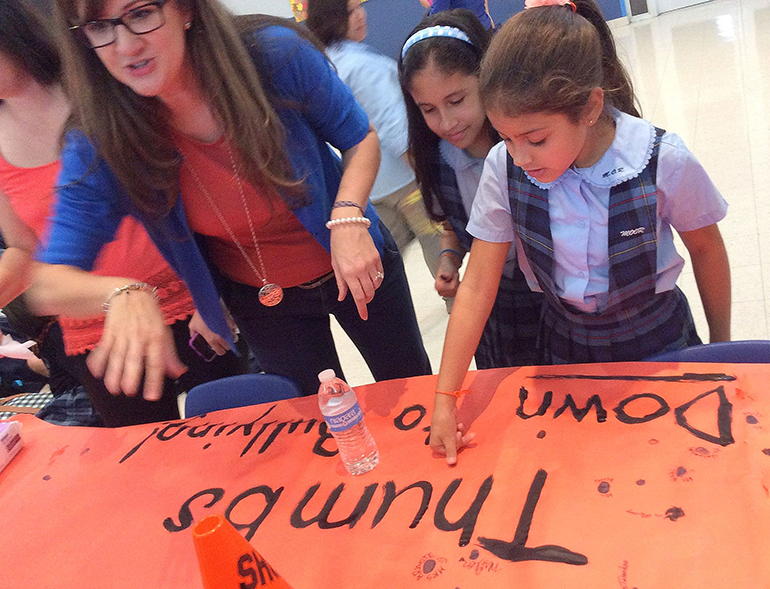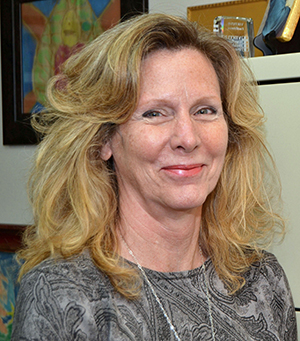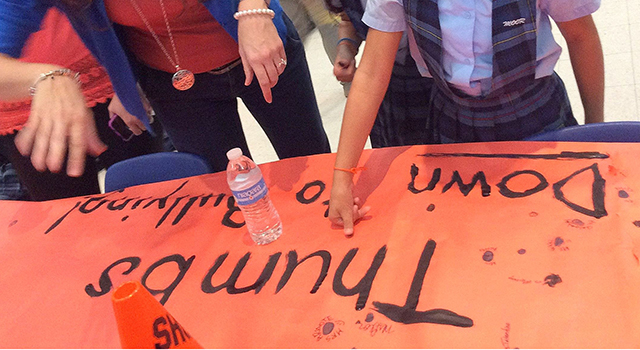By Jim Davis - Florida Catholic

Photographer: COURTESY | Mother of Our Redeemer
Students use their thumbprints to "sign" an anti-bullying poster at Mother of Our Redeemer School.
MIAMI | The online insults went on, day after day � so relentless, she had to talk it out by phone to a close friend, who was on vacation.
But the biggest shock came when the friend returned home � and confessed ruefully that she was the bully.
They both went to the counselor at their school, St. Lawrence in North Miami Beach. She suggested an unusual solution: a PowerPoint presentation on their experience.
The girls' presentation showed other students what bullying can do, and why they should shun it. And just as important, it allowed confession and "cleansing of their souls," said religion teacher Denise Broughton of St. Lawrence.
"Now they're best friends again and going to Catholic high school together," Broughton said. "Kids are forgiving."
During this Year of Mercy, declared by Pope Francis, school measures to combat bullying loom especially important. Around the Archdiocese of Miami, tactics include:
- Students learning "Healthy Choices for Teens," a DVD slide show from the Archdiocese of Miami.
- Children setting their thumbprints to a massive poster at Mother of Our Redeemer School, Hialeah, bearing the message "Thumbs Down to Bullying."
- Teaching "digital citizenship," or responsible online behavior, at St. Anthony School, Fort Lauderdale.
- Song, dance and drama at Archbishop Edward A. McCarthy High School, Southwest Ranches, driving home lessons against bullying.
- Aquinas Kindness, a girls' club at St. Thomas Aquinas High School, Fort Lauderdale, supplanting bullying with the opposite � and teaching it to students at other schools.
- A "culture of kindness" at St. Agnes Academy, Key Biscayne, teaching virtues like respect and cooperation.
Long-term effects
"It happens even in the best of schools, to the best of kids," said Michele Schneider, guidance counselor at St. Anthony School. "Even to the kid you think could never do that. Because kids are kids."
The programs are many because the stakes are high for the archdiocese's 34,000 students. In her seminars, Jan Rayburn crumples a sheet of paper as a grim object lesson. She then straightens out the sheet, showing her listeners how it still bears the crumple marks.
"It will never be the same," said Rayburn, the Virtus training coordinator for the archdiocese. "There is nothing you can do to make the hurt go away."

Photographer: JIM DAVIS | FC
Jan Rayburn, of the archdiocesan Safe Environment Office, which includes bullying in its "Protecting God's Children" program against all forms of abuse.
Many people don't know it, but the archdiocese includes bullying in its "Protecting God's Children" program against all forms of abuse. Rayburn has sent all the schools and religious education classes a narrated slide show called "Healthy Choices for Teens."
The 11-minute video, aimed at high schoolers, deals with bullying in the context of healthy or unhealthy relationships. Topics include pushing, fighting and other physical abuse; cyberbullying, or online trash talk; sexting, or sending nude photos on the Internet; and ostracism, or excluding someone from a group of friends.
The archdiocese also has schools fill out a form whenever they're aware of a bullying incident. The standards for fighting bullying, in fact, heavily overlap those for the rest of the archdiocese's decade-old program against abuse, Rayburn said.
"Much of what we're doing is about respect for self, being strong in your own skin," she said. "And when boundaries are crossed, you can speak to that person or tell a trusted adult."
Part of the problem is simply defining bullying � what it is and what it's not. Most local educators seem to agree that it's necessarily repetitive.
Schneider, the counselor at St. Anthony, uses a handy acronym � RIP: Repeated, Imbalance of Power, Purposeful. "Some students may say, 'He's bullying me,' but maybe they're just cranky for one day."
It's different if, say, a girl is hit with ridicule or cutting remarks in school �then finds more of the same after school over her cellphone or laptop or tablet.
Hiding behind computers
Cyberbullying � verbal or pictorial bashing via texts, group chats or other social media � is the new frontier of abuse. Bullies used to harass their victims all day at school. Now with phones, laptops and tablets, they can also pursue their prey right into their homes.
Online abuse was the topic of one of the first skits written by Cindy Keegan for the Maverick Players at Archbishop McCarthy High, and it looms large among more than two dozen skits. One of the most recent bulletins in the national Virtus training program for church workers � all staff and volunteers � deals with cyberbullying through gaming websites.
Cyberbullying is considered a major issue also because it's hard to police. By definition, it's away from school and outside teacher control.
"It's not like when I was in high school, when you had to say things to someone's face," said Kathie Hagood, an instructor at St. Thomas Aquinas High. "Now, you can hide behind phones and computers."
Because the cases, causes and even intensity of the incidents can vary so much, schools try to be flexible when dealing with them. The culprits may be narcissistic or coddled by parents. Or their family lives may be in turmoil. Or they may be acting out feelings of rejection or inadequacy.
"I tell our kids, 'Hurt people hurt people,'" said Schneider of St. Anthony. "But we're a Catholic school. I like to think that we try and take care of the bully as well as the victim."
She may talk to the bully alone, or with four or five kids in the class, as a subtle way to make him feel accountable for his actions. Then she later checks with him, and his victim.
"I'll say that I need to know it's going to stop; if it continues, it's out of my hands," Schneider said. "You need to give the kid a chance. And generally speaking, it does get better."
Taking action
And if it doesn't get better? The schools are ready for that, too.
At Mother of Our Redeemer, student Giovanna Pirruccio received text messages from a friend who complained that two kids in her grade were hurling insults in crude language.
"She told me, but she didn’t want to tell a teacher," said Giovanna, president of the Student Council. "She thought it might lead to further teasing. I felt it should be an issue."
The eighth grader approached Maria Acosta, social studies and religion teacher, who got both friends to fill out the archdiocesan complaint forms. The school office took it from there.
"I was confident that it was the right thing to do," Giovanna said. "I don’t think (the bullies) expected to be reported. And I'm glad that they kept it between the people involved."
Broughton at St. Lawrence School mentioned an incident during an eighth-grade field trip. A boy called a girl a crude name for a sexually loose woman, then told another she should be "deported where you came from."
Broughton had several girls write down his exact words, then called in the parents, who were understandably shocked.
"His mother said, 'How would you like someone to call me or your little sister that?'" she recalled. "He said, 'I was just roasting her.' I said, 'You call it roasting; I call it bullying.' The air in the class is a lot more relaxed now. They know I won't let that happen again."
The Catholic advantage
Catholic schools have an advantage in dealing with bullying, the educators said. They understand that people can stray, whether they're children or not.
"Do you think everybody in the church pews is perfect?" said Rayburn. "No one is perfect, only Jesus. Bullying is a great opportunity to promote the tenets of our faith: Apologize, be contrite and forgive. Even if there's not a full comprehension, or you're doing it just because you're told, how do you get better at something? You practice."
And yes, some students do get it. Like Giovanna at Mother of Our Redeemer.
"Of course our religion tells us things like this are wrong," she said. "But we're all human, and some of us make mistakes. In a Catholic school, we recognize God in our lives. Everyone is a human being and deserves respect."
For Broughton at St. Lawrence, the best example of the Catholic way is the two girls in the cyberbullying case.
"They were once foes and could have continued their lives as foes," she said. "But we patched it up. That's what Catholicism is about. Forgiving and moving on. That's the whole point of the Year of Mercy."
See related stories:


